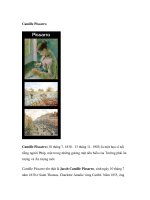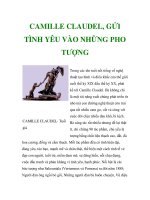camille claudel 2901
Bạn đang xem bản rút gọn của tài liệu. Xem và tải ngay bản đầy đủ của tài liệu tại đây (48.66 KB, 4 trang )
Research Paper: Camille Claudel
"Look at how lovely she is, oh, you can't imagine how lovely:
But what is loveliest about her is her hair, red as gold."
Paul Claudel, L'Endormie
Camille Rosalie Claudel was born on December 8, 1864 into a modest family, and she was the
first daughter; Henri was the oldest, but died in infancy. Louise was born in 1866 and Paul in
1868. The family moved to Paris from the Champagne region in 1881. Camille didn't quite get
along with her mother and sister. They never really understood her personality and her art, and it
was obvious that the preferred daughter was Louise. Luckily, they never had the power to smother
Camille's talent and ambition.
On the other hand, Camille was always close to her brother Paul, and her father, who recognized
her desire to create. Camille and Paul had more in common, especially their imaginative minds.
She began to work with clay as a small child, and no single event can be attributed to her passion.
"Sculpture consumed her and drew in everyone around her- her father, her mother, her brother and
sister; all had to pose for her even before she had taken a single lesson ." In an outstanding
biography, "Camille: a Life", author Odile Ayral-Clause explains that Camille's early work
attracted the attention of the sculptor Alfred Boucher. Boucher, like Camille, had started to sculpt
as a child. A scholarship to the École des Beaux-Arts helped him mature into a successful sculptor
who exhibited regularly at the Salon in spite of his young age. Intrigued by Camille's sculptural
activities, he eventually dropped by to visit her studio. "What he saw impressed him, and since he
had a generous nature, he returned to give her the much-needed guidance that she had yet to
receive ." Under these exceptional circumstances, Camille received the same education as her
bother. The readings she discovered during this period led her to question the social values of the
French middle class, and eventually caused her to reject established religious beliefs. Hence, Paul
would later blame her for steering the Claudel family away from religion. But it was a fact that
Camille learned to think critically and especially to think for herself.
"Although Camille progressed rapidly under the supervision of her two mentors, Colin and
Boucher, she faced an important limitation in Nogent: the lack of facilities offering serious
advanced studies in art for women. In many provincial towns, art instruction was provided by
schools of design modeled after the École Gratuite de Dessin pour les Jeunes Filles in Paris. Most
of these schools, however, focused on giving women the tools to earn a living either in
manufacturing or in teaching, and none of them permitted women access to nude models.
Propriety was an important concern, but the lack of confidence in women's ability to produce any
kind of serious art work played a major part in upholding this tradition." Ayral- Clause also points
out that in the 19th century, the naked body was the center of all art. When women were barred
from nude studies, they were also excluded from the main stream of art. Paris, however, offered a
variety of art schools and ateliers where women had the opportunity for serious art studies as well
as access to nude models.
So, in 1881, Madame Claudel reluctantly moved with her three children to the Montparnasse
apartment, Paul was enrolled in the prestigious Lycée Louis-le-Grand, and Camille started her
studies at the Académie Colarossi She rented her first studio on rue Notre-Dame-des-Champs,
which she shared with three English girls, students she probably met at the academy.
Camille Claudel and Rodin probably met in 1883. Soon after that Camille left her studio to work
at Rodin's as his assistant. Much attention has been focused on Claudel's relationship with her
teacher and lover. The relationship became important as it affected both artists' work. Camille
during this period affirmed and fixed her own style. Working with Rodin Camille had the chance
to study the nude figure, an usual opportunity for a woman in the 19th century. This chance gave
her a profound understanding of the anatomical forms, which shows in her work. She modeled
hands and feet for Rodin's Burghers of Calais and posed for figures in his Gates of Hell.
During this period, Rodin's and Camille's styles were very similar, and two of Camille's work are
worth mentioning: Young Woman with a Sheaf (1890) and Study for a Head. Although her work
was influenced by Rodin, it shows none of the tension characteristics of Rodin. "Yet simple,
semi-naturalistic style of this young girl is pure Camille Claudel ." Camille specialized in small
scale sculptures, and she produced multiple editions of the same work to meet the demand from
the private collectors. Young Girl with a Sheaf was one of the many that she produced in several
versions.
In 1892 Camille made the Bust of Rodin which was considered a masterpiece. In 1893, another
masterpiece was created, The Waltz.
But it was not until the 1890s that Camille demonstrated the full measure of her art, at a time that
her relationship with Rodin was beginning to deteriorate. In 1983 Camille started to separate her
work and her daily life from Rodin, and she moved into her own studio. "Rodin's work and stature
occupied front stage in French culture; Camille secluded herself in her studio to disassociate
herself from him and try to establish her own reputation. "
At this point, Claudel was determined to break with the style of Rodin's school, a courageous
move since she had no other influences or sources to fall back on . Also, Camille started to realize
that with Rodin she would always be his mistress, and that he had no intentions of marrying her.
On the top of it, her work was always connected to his name and influences, and she wanted to be
recognized by her own talent and achievements. She understood that her work would never grow
under Rodin's shadow and she refused to settle.
However, dealing with the separation was not easy for Camille. The work she produced through
these years expressed her pain and the lost love. Sakountala, from 1905, shows two lovers, a
theme very present from the beginning to the end of her career. This is one of her most famous
work, which perfectly portrays her passion and pain. It is one of my personal favorites, in which
Camille's feelings and personality are so well portrayed. Another piece of art from this time is The
Age of Maturity (1902), which shows an man standing in front of a woman and she is on her
knees, as if begging for his love, and another one, standing up next to him. Many read this man to
be Rodin between Camille, on her knees begging for the love she never fully received from him,
and the woman he would eventually marry, Rose Beuret. Some say that Camille was too proud to
portray herself on her knees, but I think that she was also very honest about her feelings and that
time of her life was very hard, she felt really alone. The Age of Maturity is one of Camille's most
moving pieces of art, in my opinion. It shows love, despair, and all the craziness of her
relationship with Rodin.
Maturity, 1902.
Another pieces of work that were inspired by her tumultuous relationship with Rodin: The Prayer
and God flown Away, which shows her anguished state, in which the "God", her love for Rodin,
had flown away.
Her love for portraying the human form resulted in certain sculptures that the state and the
infuriated press censored as overly sensual and inappropriate for public display. These
circumstances may have contributed to the decline of her career and her mental state, but
fortunately Camille was strong enough to not let critics tell her what to do, and she continued to
pursue her own style.
In spite of The Gossipers, in 1895, Camille's career was not making much headway nor could she
prove to the critics that she was no longer just a pupil of Rodin, or that, from now on, her art was
entirely her own. There is not a clear explanation to her self-seclusion, but it is obvious that in her
mind her enemy was not the public or the critics, but Rodin himself. There are still a few different
hypotheses to the reason that led Camille believe in a "Rodin conspiracy". She had an obsession
with plagiarism, and one of the explanations is that Camille had during her life given away part of
her genius to Rodin and now she could not get it back from him. Rodin's critics agree that the style
he developed in the 1880s coincides with his meeting Camille. That makes a lot of sense in my
personal opinion.
In the book "Camille: The life of Camille Claudel", the author explains:
"This small number of statues- they can be counted on the fingers of one hand- that Camille
actually signed while she was working with Rodin is in a way astounding. By all accounts, she
worked long and hard and not just on beginner's exercises but on works of great quality. What
happened then to all those days, months, years of sculpting unless she was creating works for
Rodin? Probably, too, it did not matter to her at the time for, typical of a woman, she was ready to
give Rodin everything- not only her life but her art. But once his hold was broken and affection
had turned into hate, despair set in. Camille was certain that she had been robbed of her vital
energy, in a sense of her life. How else to explain that she considered it an insult to be taken for
one of Rodin's students when it was meant as a compliment? " Well, Camille was simply tired of
being compared to Rodin, as if her work by itself wouldn't be "good enough". She wanted to be
herself and create her own art, and show to a world of men that she was a talented young woman.
Her work wasn't a mere "copy" of Rodin's, as many judge her to be. She was much more than that,
she portrayed emotions from a woman's point of view.
In my opinion these ideas make sense, but I have to comment on the passage that says ""typical of
a woman"; I think that the author should have explained more the concept of what would be the
typical behavior of a woman of the 19th century, not only " a woman". I doubt that today a woman
artist would be happy to only be recognized as a man's student and spent years of her career
creating for him and not signing anything for herself. I think that Camille saw that too, and refused
to conform to what society expected from her. She knew she had an amazing talent and that if her
work was going to be recognized as Rodin's, she would probably rather not have any recognition
at all. In 1902, Camille refused an invitation to show in Prague largely on the grounds that she did
not want to see her work exhibited next to Rodin's. She wrote to the organizer of the exhibition:
"It is true that in Prague, if I agreed to show next to M. Rodin, he would act as he pleased to keep
me under his protection and pretend that my works were his inspiration; that way my chances of
being successful, since they come from him, would return to him directly. ( ) " Camille knew that
by working with Rodin, or exhibiting her works next to his, she would only contribute to his
success, and she was determined not to let him become even more popular at her expense, even if
that would jeopardize her own career.
Regardless of the reasons, it was a fact that Camille was very depressed and neglecting herself,
living in bad conditions. From 1905 on, her obsessions turned into psychoses. She would create
her sculptures on a state of euphoria and then destroy them when depressed. Her letters to Paul, to
whom she confided everything while begging him not to reveal her thoughts to anyone, indicated
not only confusion but a real paranoia. It was really hard for her to see the man whom she had
inspired with her own talent advance toward fame; that may have been too much for Camille.
Her father and brother helped her financially, but she had no real emotional support from her
family; her mom and sister didn't care much about her situation, her dad was a conservative
business man who probably had no time for her either. And Paul, although always close to his
sister, had a career as a diplomat to worry about. From 1895 to 1909 Paul Claudel was far from
Europe. This separation from her brother during the most painful time in Camille's life, a time she
most required tenderness and help, must have been a determining factor. It just seemed more
"convenient" for everybody if she was sent away, as a problem nobody wanted to deal with. She
clearly needed some help and no one stepped up, so finally her brother committed her to a lunatic
asylum in 1913. But the main question that no one seems to be able to answer is: was Camille
really "mad"? Some people think that she was locked up at this mental institution because she was
seen as a "disgrace to society", especially to her family. She was a strong woman who lived her
life according to her own principles, not what people imposed on her. She had a strong sense of
independence and a firm belief in her own considerable talent, so she challenged the social and
artistic limitations imposed upon women of her time; this caused problems with her family
(especially her mother and sister, who disapproved of her free spirit), with Rodin, with the critics
and her public in general. Camille did become mentally ill because of the circumstances of her
life, but the 30 years she spent locked up were not intended to help her or "cure" her in any way.
Apparently, her family was not interested in seeing Camille out, because she became a "threat" to
their image because of her unconventional way of life; Rodin also didn't try to help her since
Camille was very much a "threat" to his ego and career- the woman he taught and actually became
his inspiration.
For her last 30 years of life the gifted French sculptor lived secluded from society. She was
"crumbled beneath the combined weight of social reproof, deprivation, and art-world prejudices. "
From the asylum, Camille wrote letters to her mother, her brother, her friend Maria Paillette and
Eugene Blot. "This correspondence- taking into the excesses caused by her psychosis- reveals a
sharp mind, a memory that is intact and shows that with the passage of years Camille grew more
accepting of her sufferings. " Her life simply no longer interested her.
Camille died at age 82, in 1943. But her life would be rediscovered in the 1980s, even though
neglected for years in France. For a long time her name was simply associated as "Rodin's
mistress". It is such a shame that it took so long for her to finally be accepted and appreciated for
her own talent and the amazing work she produced over the years. It is important to notice that
"because her illness kept her from venturing very far, her work may, in fact, appear timid and from
another era. Some will reproach her for not having known how to break off completely from
Rodin- with her reason rather than just her emotion. " But these accusations are quite false.
Camille did acquire her own style and uniqueness. Her themes were passionate and mostly
connected to the female soul: her family, her love, her fears.
Today, Camille Claudel is known to be one of the last of the great humanist sculptors. A fortune
has been made on her tragic story: movies, biographies, endless studies on who was the talented
French sculptor who refused to settle for anything less.
I think any person, would have a lot to learn from the life of this amazing woman. I really like this
quote, which helps one understand who Camille Claudel was:
" Her work stands alone and will appeal only to those for whom art is still the representation of
human emotions. For them, the lively freshness of her busts, the natural and almost earthy
sensuality of her bodies and faces that contrasts with the quasi- Asiatic elegance of the surfaces
and the gesticulation of the figures- therein is expressed the bittersweetness of life, as savored by a
woman. "
Bibliography
Ayral-Clause, Odile. Camille Claudel: A Life.
New York: Abrams, 2002.
Paris, Reine-Marie. Camille: The Life of Camille Claudel.
Trans. Liliane Emery Tuck. New York:
Arcade Publishing, 1984.
Camille Claudel. Artcyclopedia.
/>Koenigsmann, Wendy. Camille Claudel, of Dreams and Nightmares.
/>Ebert, Roger. Camille Claudel. Chicago Sun Times. 9 March, 1990.
/>Some Beautiful (if Tortured) Works of Camille Claudel. Washington University
in St. Louis. />Vilain, Jacques. Camille Claudel. Musee Rodin.
/>Deters, Sigrid. Strong Emotions. Feb 16, 2001.
/>The National Museum of Women in the Arts, Camille Claudel (artist profile).
/>









